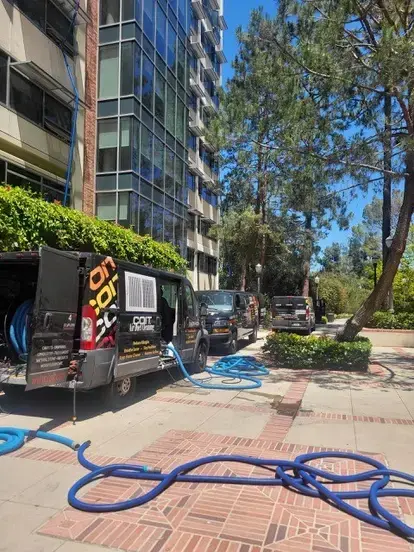
Case Study: UCLA
Key Success Factors
- State-of-the-art commercial cleaning equipment and methods
- Strategic planning and understanding of UCLA’s campus layout to effectively dispatch cleaning crews
- The ability to mobilize a large fleet of 19 technicians to efficiently clean without sacrificing quality
- Flexibility and accommodation to the university’s schedule
Project Timeline
- Start Date: Sunday, June 15th
- Projected Finish Date: Sunday, June 22nd
- Actual Completion Date: Thursday, June 19th
- Total Duration: 5 days

The Challenge—Deep Cleaning Over 1.4 Million Square Feet of Carpet
Located at the base of the picture-esque Santa Monica Mountains, the University of California, Los Angeles (UCLA), is renowned for its top-tier academics and athletic programs, consistently ranking it as the nation’s #1 public university.
With a community of around 90,000 individuals, including staff and students—the largest enrollment among the University of California’s 10 campuses—UCLA experiences its fair share of daily foot traffic throughout the year. With so many people traversing to class, to the library, to the cafeteria, to the dorms, and so on, dirt and allergens are easily tracked in from one building to the next, inevitably contributing to the spread of bacteria. For these reasons, keeping a campus clean is of the utmost importance.
A Clean Campus is a Safe Campus
Simply put, cleanliness and academic success go hand-in-hand. Not only does a clean campus make a good first impression to new and prospective students, but it also shows the university cares about its students’, staff’s, and guests’ well-being. According to a study conducted by Brigham Young University, there is a direct correlation between cleanliness and academic achievement. Among noise, air temperature, and lighting, cleanliness ranked as the fourth most important element impacting productivity levels, emphasizing it as a top priority for educational facilities.
While some clutter and dirt can be seen with the naked eye, many allergens, pollutants, and bacteria, such as dust mites, mold, and pollen, remain unseen and can be nestled deep within carpet fibers—a common flooring type in most university dorm rooms and other academic buildings.
To promote a positive learning environment and prevent the spread of illness, UCLA partners with the experts at COIT each year to perform a routine professional carpet cleaning, servicing eight dorm buildings and five dining facilities quarterly, totaling over 1.4 million square feet of carpet.
Since around 1998, COIT has been partnering with UCLA to perform annual professional cleaning services, and each year the school adds on more square footage for technicians to tackle. Professionalism, ability to dispatch large crews, and efficiency without sacrificing quality were all cited as reasons UCLA continues to team up with COIT.

Here’s how COIT gets the job done each year.
The Solution—Large Crews and a Tactical Cleaning Approach
The average office building floor is ~20,000 square feet. In this case, COIT was tasked with cleaning the equivalent of 70 office floors. A project of this size requires the ability to mobilize large teams of technicians and determine a strategic plan of action to ensure timelines are met and the university can focus on other preparations before the new semester.
To avoid any disruption during the actual school year, COIT operates during the summer months while most staff and students are away to prepare the dorm rooms before the start of the fall semester.
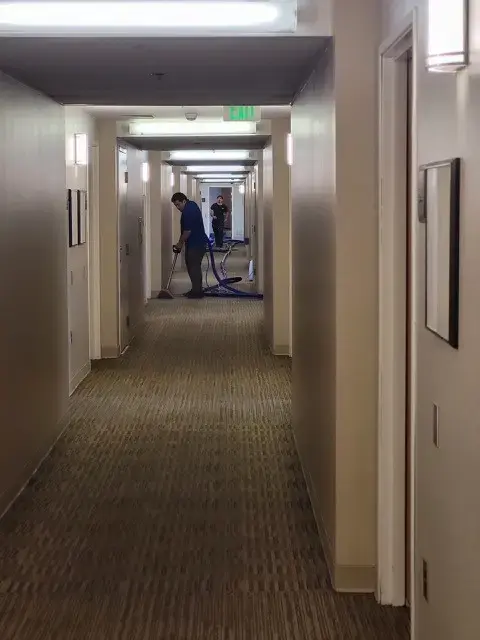
Professional Carpet Cleaning, Dorm-by-Dorm, Floor-by-Floor
With a crew of 19 certified technicians, the COIT teams split up into designated teams, each assigned to the following dorm buildings: Olympic Hall (342 rooms), Centennial Hall (277 rooms), Reiber Terrace (499 rooms), Reiber Hall (551 rooms), Hitch Suites (81 apartments), Hendrix Summit (264 rooms + 26 pods), Hendrix Hall (426 rooms), Saxon Suites (307 rooms).
With a grand total of 2,773 spaces to clean, the work requires meticulous and efficient effort. Through calculated planning and maintaining organized and professional steam cleaning systems, COIT crews can streamline the carpet cleaning process to get in and out of dorm rooms as efficiently as possible without sacrificing quality.
Additional UCLA Facilities Cleaned
In addition to cleaning the carpets in the dormitory buildings on an annual basis, UCLA also entrusts COIT to deep clean the carpets in the various dining halls (performed quarterly), along with the UCLA University Club, Powell Library, and the Meyer & Renee Luskin Conference Center (a hotel for visiting athletes during university events).
The Effectiveness of Steam Cleaning Carpets
Steam cleaning, also known as hot water extraction, is a cleaning method whereby hot water vapor at high pressure is used to loosen dirt, debris, and bacteria trapped in carpet fibers. Once loosened, a powerful vacuum then extracts the dirty water and transports it through a hose and into a tank.
According to the National Center for Healthy Housing (NCHH), “Steam cleaning is likely to be more effective against dust mites and does not require the use of pesticides.” When dust mites and other allergens are of concern, this makes steam cleaning an ideal option for universities that house thousands of students each year.
Advanced Cleaning Equipment and Solutions Used
Commercial carpet cleaning of this scale requires truck-mounted steam cleaning equipment to ensure the highest power and mobility to navigate the dorm’s various floors with ease. To treat the carpets, the following tools and solutions are used:
- HEPA (High Efficiency Particulate Air) filter vacuums—to limit the amount of dust emitted by the vacuum
- Dual and Quad Jet Carpet Wands—for high-efficiency extraction
- Enzyme Pre-Spray—for deep breakdown of organic matter in carpets
- Fiber Rinse Neutralizer—to stabilize pH and prevent residue
- Rainbirds—used for water distribution and soil loosening
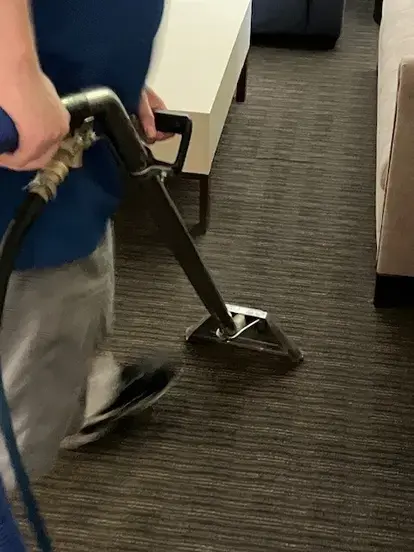
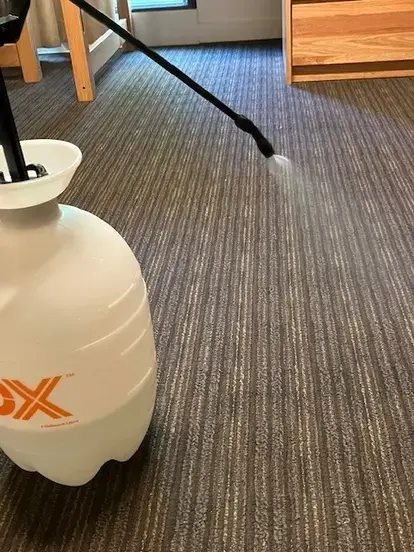
Prioritizing Safety and Eco-Friendly Cleaning Practices
In place of chemicals, COIT uses biodegradable cleaning solutions and drains soiled water into the sanitary sewer drains available on campus. Our technicians follow strict safety precautions, including the use of safety gear and gloves, so they are not exposed to any of the solutions. In addition, they place “COIT Working” signs for students and faculty to know they are working and to mitigate their exposure as well.
The Results—A More Sanitary and Welcoming Space to Study
It is a university’s greatest responsibility to prioritize education, empower students to grow personally and professionally, and provide them with a space that facilitates learning. When students can focus on their studies without being bogged down by sickness or allergy symptoms associated with dirty living conditions, academic success is easier to achieve. This is where COIT comes in.
Through this continued partnership, UCLA experiences measurable improvements, including:
Mitigating the Spread of Bacteria
Steam cleaning involves using intense heat temperatures (~200-300 degrees Fahrenheit) and water pressure to loosen and eliminate bacteria, germs, and viruses without the use of harsh chemical solvents.
Extending the Life of Carpeted Floors
Over time, dirt and other particulates act as irritants on carpet fibers and can be abrasive, wearing them down and causing them to look frayed. By servicing carpets on an annual basis, these particles are removed more regularly, and carpets will therefore not only look better, but last longer without requiring costly repairs or replacement.
Improving Air Quality
Given their ability to trap dust and other particulates from the air, carpets act as an air filter. When dust and other particles are left to sit within carpet fibers, this inevitably becomes what the inhabitants inhale. With reduced airborne allergens, bacteria, and other substances, studies conducted by the NCHH show that regularly cleaning carpets has a direct contribution to improved air quality.
Limiting Absenteeism Due to Illness
Sick days mean students miss out on valuable lessons and peer-to-peer interaction, which can hurt overall academic achievement. In doing their part to ensure that dormitory flooring is professionally deep-cleaned while students are away for the summer, i.e., ensuring they clean every square inch and go beyond a standard surface-level clean, UCLA is lessening the chances of unforeseen absenteeism due to sickness during the school year.
While there was an initial projected timeline of one week, the COIT team was able to surpass initial timeline expectations and clean 1.4 million square feet of carpet in just five days. By completing the work ahead of schedule, we provided UCLA with extra time to inspect and review the finished work prior to students returning, ensuring they are welcomed with a clean and safe space to live before the start of the new academic year.
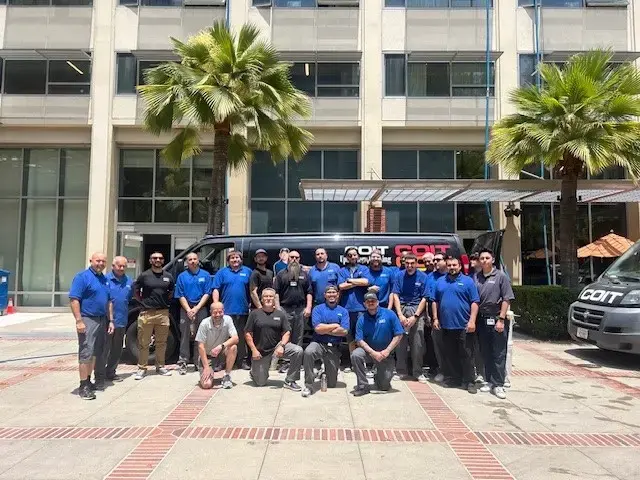
The project was led by General Manager Gary Hamilton and Operations Manager Joshua Serrano, with a crew of 19 COIT technicians on site.